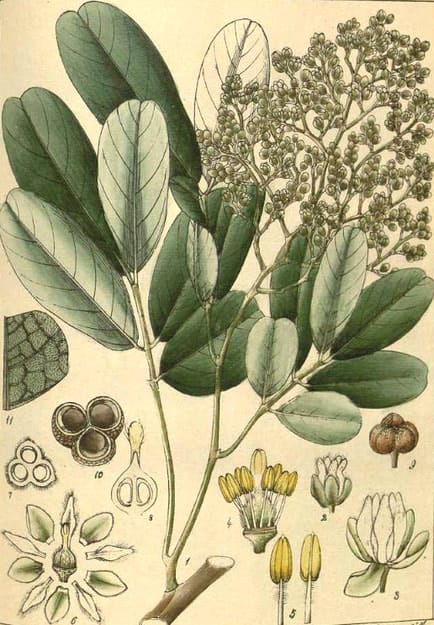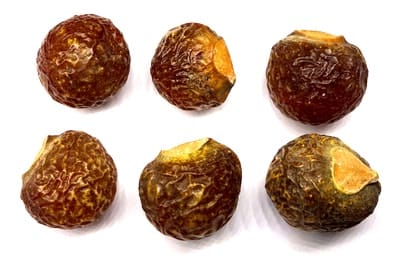Sapindus, Soap nut, Arishtaka
Arishtaka (Ayurveda)Maghz e Bunduq, Post e Ritha (Unani)
Puvamkottai (Siddh)
 Sapindus
SapindusR. Wight, Illustrations of Indian botany, vol. 1 (1840)
 Soap Nut (Calcutta Unani College, Adam, 2019)
Soap Nut (Calcutta Unani College, Adam, 2019)Botanical name:
Sapindus laurifolius (syn. S. trifoliatus), S. mukorossi, S. emarginatus, S. detregens, S. rubiginosus
Parts used:
Pericarp of the Fruit; sometimes the kernel
Temperature & Taste:
Warm, dry. Bitter (Considered Cool–Neutral in Tibetan Medicine)
Uses:
1. Clears Heat and Toxin: (Ayurveda, Unani, TCM, Tibet)
-Fever; ‘especially Quartan Fever’. (Avicenna)
-swollen sore throat (TCM, Tibet)
-Carbuncles, pyogenic Infection (TCM)
-Food poisoning
-Snake Bite; bites of Rabid animals, Scorpion and Spider bites
2. Astringes to Stop Leakage: (Ayurveda, Unani, TCM)
-Spermatorrhea, increases retentive power of Sperm (prolongs ejaculation) (Ayurveda, Unani)
-Leukorrhea (TCM)
-Malnutrition (TCM)
-Hemorrhoids
-Diabetes (Unani)
3. Moves the Blood, Promotes Menstruation: (Ayurveda, Tibet)
-Amenorrhea, Dysmenorrhea
-expels Placenta and a Dead Fetus
-Female Infertility (taken every morning for 2 months) (Ayurveda, Tibet)
-to prevent Conception (Nighantas)
-Tincture was preferred to promote Menstruation
-also in pessaries to promote Menstruation, stimulate Labor, and expel a Dead Fetus
4. Clears Phlegm, Stops Cough: (Ayurveda, TCM)
-Cold-phlegm type Cough, Asthma
5. Purgative:
-used as a purgative in full doses
-‘Soap-nut evacuates black bile, phlegm, yellow bile and other fluids from the body without any ill effects’. (Avicenna)
-full doses can also be Emetic
6. Settles Wind, Stops Spasms:
-Spasms, Convulsions, Epilepsy (Unani)
-Hysteria
-the suds put into the mouth during a fit of Epilepsy is said to restore them instantly (Ainslie)
7. Kills Worms:
-used for Worms; Ascaridia
-as a wash for Lice
8. Externally:
-decoction used topically for ear ache (Thailand)
-as a collyrium to Cataracts
-as a wash for Pruritus of the skin, Rashes, Ringworm, Tinea (Avicenna)
-Leucoderma (Vitiligo)
-strong decoction for Lice
-decoction is used as a hair wash and shampoo
-powder mixed with vinegar and applied to beautify the skin
-mixed with vinegar and applied to Ulcers
-used as a snuff to promote sneezing in sinusitis; also for Headache, Epilepsy, Facial Paralysis etc. (Unani, Avicenna)
-as a snuff for Mania and Melancholy (Avicenna)
-gargle is very effective for Diphtheria (Unani)
-painted on with Vinegar to Scrofula (Avicenna)
-fumigation in Melancholy and Hysteria
Dose:
1. Full doses are emetic and purgative; small doses are expectorant
2. Avicenna said it is taken with Sweet Wine or Oxymel.
250mg is used for Colic
500mg–1 gram is expectorant
3–6 grams in powder is purgative
Infused in Wine or Oxymel: 3–7 grams (to be sipped)
Main Combinations:
1. As a purgative, Avicenna said it was taken with Scammony and other ingredients.
2. Hemorrhoids, Sapindus fruit (kernel removed), Tragacanth (equal parts). Form pills and take one as big as a Chickpea. (Unani)
2 Diabetes:
i. Sapindus fruit (kernel removed), Tragacanth, Zinc Kushta (Bhasma). (Unani)
ii. Sapindus fruit with Tin Bhasma
3. Spermatorrhea, Sperm tonic, premature ejaculation, Sapindus fruit with Tin Bhasma
4. Hyperlipidemia, Sapindus fruit (kernel removed), Fenugreek seed, Plantain seed (proven effective)
5. Facial Paralysis: Avicenna stated ‘It has been successfully tested as a useful drug for facial paralysis when taken as a snuff for three consequent days. This treatment enables the fluid and phlegm to flow out profusely from the nostrils and the disease is cured within three days. During this process the patient of facial paralysis must be confined to a dark place’.
6. Keratitis, Day-blindness: ”The extract of the small soap nut, if sniffed with the water of sweet marjorum, is particularly useful in vascular keratitis and day-blindness’. (Avicenna)
5. Rabies, Fruit powder made into pills with Neem oil for someone bitten by a Rabid animal (Folk Medicine)
6. Worms, Sapindus with Pongamia and Butea
7. As a hair tonic, make a wash of Sapindus with Emblic Myrobalan (Ayurveda)
Major Formulas:
Cautions:
Avoid overdose
Main Preparations used:
-
Extra Info
-
History
|
‘The soapnut, in Sanskrit Phenila and Arishta, has probably been in use among the Hindus from the earliest ages as a detergent, and is still used in preference to soap for certain purposes, just as the soapworts were formerly used in the West. Malachias (3) writes: “He is like a refiner’s fire and like fuller’s Borith, &c.” In the Septuagint (270 B.C.) Borith is translated ‘xxx’ and in the Vulgate ‘herba’; the old English translation as *sope.’ Malachias’ description of the purgation of the sons of Levi is exactly similar to the process to which the Indian goldsmith submits his ornaments. Both Hindus and Mahometans use it medicinally; the latter give it the name of Banduk or Finduk-i-Hindi (Indian Filbert). In the Nighantas it is described as hot, and a preventive of conception. The following account of its properties is extracted from the Makhzan-el-Adwiya :— ” The pulp of the fruit is at first sweetish to the taste, afterwards very bitter; it is hot and dry, tonic and alexipharmic ; four grains in wine and sherbet cure colic; one miskal rubbed in water until it soaps, and then strained, may be given to people who have been bitten by venomous reptiles, |
and to those suffering from diarrhoea or cholera. Three or four grains may be given by the nose in all kinds of fits producing insensibility. Fumigations with it are useful in hysteria and melancholy; externally it may be applied made into a plaster with vinegar to the bites of reptiles and to scrofulous swellings. The root is said to be useful as an expectorant. Pessaries made of the kernel of the seed are used to stimulate the uterus in child-birth and amenorrhcea. One. miskal of the pulp with one-eighth of a miskal of scammony acts as a good brisk purgative.” Rheede describes the tree as anti-arthritic, and says a bath is prepared with the leaves, and the root is administered internally. Ainslie mentions the use of soap-nuts by the Vytians as an expectorant in asthma. In India the pulp of the fruit is given as an anthelmintic in small doses. The bark is astringent. Soap berries are used in France for washing silk dyed with aniline colours. We have no record of the use of this fruit as a poison for human beings, doses of 70 grains and more appear to have no injurious effect upon the system when taken as a purge.’ (Pharmacographia Indica, Dymock, 1890) |
